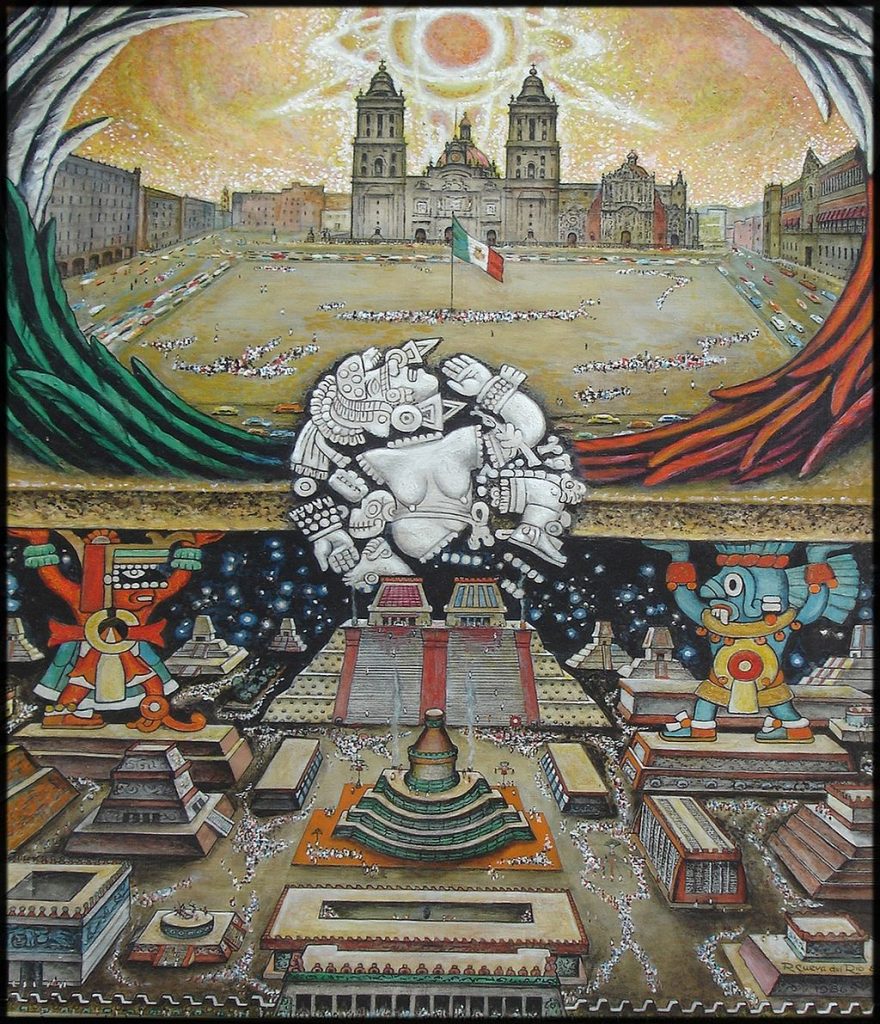When the Spanish conquistadors arrived in the valley of Mexico, they discovered something mystical. They viewed this place as the Venice of the New World. There were glamorous pyramids, exceptionally clean streets, grand aqueducts, lavish ball courts… all floating on a lake. This magical city, known as Tenochtitlan, was built by the Aztecs, the same group of people many look down upon because of their brutality, ferocity, and their practice of human sacrifice. Though many view the Aztecs as cold-hearted murderers, this is not the full story. Yes, they did practice human sacrifice, but much like other civilizations, they also had art, building projects, literature, religion, and a rich culture. But how is it that these people became a superpower of the Americas?
According to legend, the Aztecs, also known as the Mexica, hailed from a beautiful place known as Aztlan, which means “Land of the cranes.” Much like the mythical Greek city Atlantis, no one really knows where Aztlan is or even if it existed. In fact, the Aztec story about Aztlan is only one of several origin stories they tell. One legend has it, however, that one day their god, Huitzilopochtli, told the Mexica people to leave their land and find a new home, and they did. After more than two centuries of migrating, the Mexica grew more and more desperate to find that new home. Then they discovered the valley of Mexico. But they weren’t the only ones to settle there. Tribes such as the Azcapotzalco, the Culhuacán, and the peoples of Texcoco had gotten there long before they had. The only land that was still available to the Mexica was the nasty marshlands around Lake Texcoco, which the others had not wanted. And yet it was here that the Mexica had a vision. It was here that their sun god Huitzilopochtli gave them a sign: an eagle perched on a cactus eating a snake. That is why Mexico’s flag today has an eagle eating a snake. It meant that the Mexica (the Aztecs) had finally found their new home.1
Settling down in the Valley of Mexico was anything but easy. For one thing, objects would sink easily in the poor marshy grounds, which were in the middle of Lake Texcoco; yet this is where the Aztec’s creative engineering would come into play. Under their leader Tenoch, from which the name Tenochtitlan comes, the Aztecs began building their new home, by trading waterfowl and fish for wood and stone from the other tribes.2 With the wood, they made stakes, which were driven into the marshy ground. They then filled the gaps in between the stakes with mud and stones, which would become a foundation for their city. In order to connect the island city to the mainland regions, they also made gigantic causeways, using the same principles for making their foundation and were several miles long. Another problem was the water in Lake Texcoco, which was salty. The Aztecs had to build an aqueduct that would transport fresh water from the distant Chapultepec hills to the city itself. This aqueduct used a pair of stone pipelines that used gravity to transport the water to the city, and parts of it still stand to this day.3 Though they fixed their foundation and their water problems, there was still one problem that the Aztecs had to face before they could become the dominant force of Mesoamerica.
As their population kept growing, the demand for food kept rising at an alarming rate, and this is where the Aztecs are distinct from other civilizations. First, they dug canals into the island’s marshes and chopped down the plants that were growing there. They then piled reeds on top of each other to make rafts and covered them with mud. Finally, they planted willows underneath the rafts to anchor them. And voilà, the Aztecs had their very own artificial floating gardens, known as chinampas. With water always available, these chinampas could produce crops year round, thus the Aztecs had an abundance of beans, corn, tomatoes, squash, and flowers.4

After several generations, Tenochtitlan became a city of wonder and reached a population of around 200,000 inhabitants, making it one of the largest cities in the world.5 The city was decorated with structures, such as the serpent wall that enclosed the sacred quarters of the city and contained the carvings of snakes. It also contained lavish temples, such as the temple of Xipe Totec and the temple of Quetzalcoatl, the god of the sky and wind. But at the heart of Tenochtitlan was an impressive sight to see. This magnificent edifice, known as the Templo Mayor, was a temple like no other. This 150 feet pyramid had a twin staircase that led up to the glamorous temples of Tlaloc, the rain god, and Huitzilopochtli, the same god who provided the Aztecs with the vision of their new home.6

In the Aztec tongue, Nahuatl, their word for city is actually two words in English: water mountain (atl tepetl).7 In many ways, Tenochtitlan was a mighty mountain that watched over the valley of Mexico with its striking glare. Long before Mexico City became a glimpse in the eyes of history and replaced this magnificent place, Tenochtitlan was a flourishing capital that was not necessarily built by a brutal and violent race. But rather by a people who didn’t let the impossible stop them from making their home a legendary reality.
- Jennifer Stock, “Tenochtitlán Is Founded,” Global Events: Milestone Events Throughout History, (Farmington Hills, MI: Gale, 2014), 23-24. ↵
- Jennifer Stock, “Tenochtitlán Is Founded,” Global Events: Milestone Events Throughout History, (Farmington Hills, MI: Gale, 2014), 23-24. ↵
- Sonia Benson, “The Rise of the Aztecs,” Early Civilizations in the Americas, Vol. 2 (Detroit: UXL, 2005), 465. ↵
- Sonia Benson, “The Rise of the Aztecs,” Early Civilizations in the Americas, Vol. 2 (Detroit: UXL, 2005), 461-462. ↵
- Sonia Benson, “The Rise of the Aztecs,” Early Civilizations in the Americas, Vol. 2 (Detroit: UXL, 2005), 461. ↵
- Charles Phillips, Aztec and Maya: The Complete Illustrated History: The Greatest Civilizations of Ancient Central America with 1000 Photographs, Paintings and Maps (New York: Metro Books, 2008), 430-431. ↵
- Charles Phillips, Aztec and Maya: The Complete Illustrated History: The Greatest Civilizations of Ancient Central America with 1000 Photographs, Paintings and Maps (New York: Metro Books, 2008), 56-57. ↵




43 comments
John Smith
It’s impressive how far the Mexica went to create the great city of Tenochtitlan, truly an impressive work of Mesoamerican ingenuity and a staple of Native Latin America. I’m sure the creation of such a great city was the backbone of the Aztec Empire. It’s a shame that a large chunk of the Aztec’s art and culture would be lost to oppression and European “influences”.
Antoinette Johnson
This article is intriguing because most of the time people associate the Aztecs with being brutal and savage people. The Aztecs were far more than what people thought. The never gave up and even though they faced many hardships like the marshy land and traveling to find a home for two centuries they did not let that stop them. They worked together to make the best of the land they found. Through hard work, they were able to make the land extraordinary and the legend it is today.
Kristy Feather
I think it’s fascinating to see how people are willing to give up fertile land to follow what their god tells them. The Aztec people were thought to be doing well before they migrated to the marshlands which to me just seems insane. Nonetheless the empire they built for themselves does a great job of showing just how advanced they were technologically. I think this article did an amazing job of showing both the religious, economic and intellectual ideologies that the Aztec people had.
Gabriela Ochoa
I liked this article a lot it really did describe how the Aztecs were and how their society worked. I find it interesting that they would move to a place that isn’t as “supportive” to them as their last location was just because their god told them too. But they did adapt well and created aqua-ducts, traded with other tribes , and learned how to grow their own crops. Even though they were big and beautiful cities I find it hard to believe that Tenochtitlan and Atlantis could just disappear so easily.
Christopher Hohman
Nice article. Tenochtitlan was truly a city of wonder. The Aztecs were so powerful and so wealthy and all that wealth culminated in the building of their great capital. I never knew that the eagle eating a snake on top of a cactus was their legend for finding the location for their city. That is cool how that image is now part of the Mexican flag. A true homage to their great ancestors. The city and the culture they built were quite extraordinary
Madison Downing
You are such an amazing writer I don’t think I read an article this quick before! I really appreciated how you put the Aztec words into English for us readers and kept telling us which god was which (not just stating who they are once and readers having to go back to remember). I actually loved the Aztecs because of how complex their cultural was and how they dealt with other people. However I didn’t know the true extent of their culture’s beauty until I read your article. I can’t believe they did this all on a swamp; the mighty civilization only had the location in the first place because the other early habitants didn’t want it, thinking it wasn’t anything worth the trouble. I completely agree with you that the old civilization made the impossible possible.
Enrique Segovia
I had heard of the story of where the Mexica people decided to concoct their city, but this article taught me that actually, a God commanded to do it where they found the image presented in the actual Mexican flag today. I was impressed by the agricultural gardens that the Aztecs built in order to survive, and I was truly shocked that such an early civilization could easily create the basis for a country like Mexico today. Finally, I liked the article because it was concise, easy to understand, and even though it talked about a totally different culture, the author makes the reader understand the people of which he talks about.
Michael Hinojosa
It’s cool to finally know the backstory on why the Mexican flag has the eagle and the snake on it since not many articles out there give the backstory on the designs of various flags from across the world. I also thought it was interesting to get a more inside scoop on how the Aztecs were as a people, describing them as advanced and sophisticated but also barbaric due to their various rituals.
William Rittenhouse
That’s cool how they were a very intelligent society who developed sophisticated ways of life. They were not saints though. They practiced barbaric rituals that would make people sick if they knew what they did. It’s a shame that they had these beliefs and rituals because if they were more sophisticated in their social customs, they might have been much more liked by the Spanish. After the Spanish defeated them they started to introduce Christianity which led to the end of the barbaric practices.
Alyssa Garza
This article was very interesting to read. I never knew why the Mexican flag had the eagle eating a snake on its flag, but I do now thanks to this article. The way they create their buildings structure is amazing to me it’s very impressive. In all of my history classes I have never heard about them being the first people to create floating gardens which is pretty cool to me.